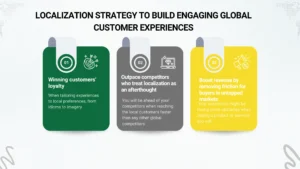Localization Strategy: How to Create the Most Delightful Global Experiences

When expanding into new global markets it isn’t just about translating words. Crafting local experiences that feel made for your customers is the key to engaging experiences all over your platforms. A smart localization strategy turns the local cultural nuance into competitive advantage for your business as it will help your team build trust, loyalty, and revenue worldwide.
Here’s why localization deserves a seat at your global expansion strategy table—and how to do it right.
Why Applying Localization for Global Growth?
Think of localization as your brand’s passport. Without it, you might reach new markets, but you won’t resonate in them with local customers’ different needs and problems. A localization strategic approach helps you:
- Winning customers’ loyalty: When tailoring experiences to local preferences, from idioms to imagery, this will strengthen the customer-brand relationship and gain a customer for lifetime.
- Outpace competitors who treat localization as an afterthought: You will be ahead of your competitors when reaching the local customers faster than any other global competitors who still use one language to communicate.
- Boost revenue by removing friction for buyers in untapped markets: Your customers might be facing some obstacles when buying a product or services you sell, removing these obstacles will turn these challenges into opportunities.
5 Steps to an Airtight Localization Strategy
 Winning over global customers requires more than just translation, it requires a strategic approach to localization that resonates across cultures.
Winning over global customers requires more than just translation, it requires a strategic approach to localization that resonates across cultures.
If you’re expanding into new markets or refining your global presence, these steps will help you adapt your products, services, and content effectively to drive growth and competitive advantage in today’s international marketplace.
- Start with Your Brand Goals, Not Just Translations
Before localizing, ask: What’s our endgame of the localization step. Localization goes around strategic choices that align with your business vision. Before diving into languages and currencies, think of the objectives that you actually want to achieve?
Driving revenue? Localization removes buying barriers, by making your brand reachable, and visible to local customers.
Building loyalty? Localization can help you post retention metrics, when offering the local audience, a solution in the local language.
Expanding influence? Localization can help you maximize your influence when communicating with locals in their language. Most locals might only use one language to communicate.
- Fund Localization Like a Strategic Growth Lever
Treat localization as an investment, not a cost center, when prioritizing spending on localization, your brand growth will be impacted. It’s suggested to dedicate 45-60% of your budget to professional human translation for nuanced cultural adaptation, 20% to essential tools like translation management systems, and 15% to in-market testing.
- Target Markets with Surgical Precision
Not all markets deserve the same effort and investment, evaluating countries by potential ROI and localization complexity can save you lots of money and put you on the road of growth in another country. When analyzing your competitors’ weaknesses in your target markets, they might only have translated websites but neglected local payment methods, that’s your opportunity to differentiate.
- Research That Goes Beyond Google Translate (Cultural Deep-Dive)
Uncover hidden cultural drivers and behavioral deep dives. Surface-level translations fail because of not conducting market-specific behavioral research, some buyers prefer detailed technical documents, while others respond to emotionally driven storytelling.
- Optimize UX for the “3 C’s”
Optimizing your website or online shop for the three C’s: Comprehension (adapt layouts for text expansion), Cultural Resonance, and Conversion (localized checkout flows improve completion rates by 70%). Japanese users need 25% more white space than Americans for optimal readability—these details matter.
- Turn Customer Support into a Growth Engine
Train your customer support team in cultural context, some customers prefer evening support (8-11 PM), while some users expect friendly small talk before issue resolution. You need localized customer support with culturally aware response protocols to build trust.
Are you ready to power up your website localization?









